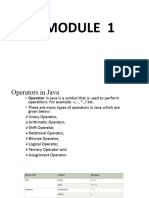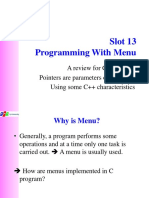Control Structures in Java
Uploaded by
Roo AnuControl Structures in Java
Uploaded by
Roo AnuControl Structures in Java
1. conditional statements in Java
Use if to specify a block of code to be executed, if a specified condition is true
Use else to specify a block of code to be executed, if the same condition is false
Use else if to specify a new condition to test, if the first condition is false
Use switch to specify many alternative blocks of code to be executed
if Statement
Use the if statement to specify a block of Java code to be executed if a condition is true.
Syntax:
if (condition) {
// block of code to be executed if the condition is true
}
else Statement
Use the else statement to specify a block of code to be executed if the condition is false.
Syntax:
if (condition) {
// block of code to be executed if the condition is true
} else {
// block of code to be executed if the condition is false
}
else if Statement
Use the else if statement to specify a new condition if the first condition is false.
Syntax:
if (condition1) {
// block of code to be executed if condition1 is true
} else if (condition2) {
// block of code to be executed if the condition1 is false and condition2 is true
} else {
// block of code to be executed if the condition1 is false and condition2 is false
}
Short Hand If...Else (Ternary Operator)
There is also a short-hand if else, which is known as the ternary operator because it consists of three operands.
It can be used to replace multiple lines of code with a single line, and is most often used to replace simple if else
statements:
Syntax:
variable = (condition) ? expressionTrue : expressionFalse;
Example
int time = 20;
String result = (time < 18) ? "Good day." : "Good evening.";
System.out.println(result);
1 Prepared by Sisira Palihakkara
Switch Statements
Instead of writing many if..else statements, you can use the switch statement.
The switch statement selects one of many code blocks to be executed:
Syntax:
switch(expression) {
case x:
// code block
break;
case y:
// code block
break;
default:
// code block
}
The switch expression is evaluated once.
The value of the expression is compared with the values of each case.
If there is a match, the associated block of code is executed.
The break and default keywords are optional, and will be described later in this chapter
break Keyword
When Java reaches a break keyword, it breaks out of the switch block.
This will stop the execution of more code and case testing inside the block.
2. Loop statements in Java
Loops can execute a block of code as long as a specified condition is reached.
while Loop
do/while Loop
while Loop
The while loop loops through a block of code as long as a specified condition is true:
Syntax:
while (condition) {
// code block to be executed
}
Example:
int i = 0;
while (i < 5) {
System.out.println(i);
i++;
}
do/while Loop
The do/while loop is a variant of the while loop. This loop will execute the code block once, before checking if the
condition is true, then it will repeat the loop as long as the condition is true.
Syntax:
do {
// code block to be executed
}
2 Prepared by Sisira Palihakkara
while (condition);
Example:
int i = 0;
do {
System.out.println(i);
i++;
}
while (i < 5);
for Loop
When you know exactly how many times you want to loop through a block of code, use the for loop instead of
a while loop:
Syntax:
for (statement 1; statement 2; statement 3) {
// code block to be executed
}
Statement 1 is executed (one time) before the execution of the code block.
Statement 2 defines the condition for executing the code block.
Statement 3 is executed (every time) after the code block has been executed.
Example:
for (int i = 0; i < 5; i++) {
System.out.println(i);
}
for-each Loop
There is also a "for-each" loop, which is used exclusively to loop through elements in an array:
Syntax:
for (type variableName : arrayName) {
// code block to be executed
}
Example:
String[] cars = {"Volvo", "BMW", "Ford", "Mazda"};
for (String i : cars) {
System.out.println(i);
}
Java Arrays
Arrays are used to store multiple values in a single variable, instead of declaring separate variables for each value.
To declare an array, define the variable type with square brackets:
String[] cars;
String[] cars = {"Volvo", "BMW", "Ford", "Mazda"};
int[] myNum = {10, 20, 30, 40};
Access the Elements of an Array
You can access an array element by referring to the index number.
3 Prepared by Sisira Palihakkara
Array Length
To find out how many elements an array has, use the length property:
Java Break statement
The break statement can also be used to jump out of a loop.
Example:
for (int i = 0; i < 10; i++) {
if (i == 4) {
break;
}
System.out.println(i);
}
Java Continue statement
The continue statement breaks one iteration (in the loop), if a specified condition occurs, and continues with the
next iteration in the loop.
Example
for (int i = 0; i < 10; i++) {
if (i == 4) {
continue;
}
System.out.println(i);
}
******
4 Prepared by Sisira Palihakkara
You might also like
- Java Control Statements, Methods and ClassesNo ratings yetJava Control Statements, Methods and Classes48 pages
- Control Flow and Decision Making Statement (Module 3) - 110945No ratings yetControl Flow and Decision Making Statement (Module 3) - 11094525 pages
- Module 4 Subtopic 1 Supplementary Material 1No ratings yetModule 4 Subtopic 1 Supplementary Material 123 pages
- A674940238 - 21789 - 9 - 2019 - 05. Control StructuresNo ratings yetA674940238 - 21789 - 9 - 2019 - 05. Control Structures48 pages
- An Overview of Java Statements: 4. 1. 2. ExpressionsNo ratings yetAn Overview of Java Statements: 4. 1. 2. Expressions40 pages
- Java Control Statements - Control Flow in JavaNo ratings yetJava Control Statements - Control Flow in Java16 pages
- ControlStatementsinJavapdf 2024 08-28-16!17!42No ratings yetControlStatementsinJavapdf 2024 08-28-16!17!4217 pages
- Modern Programming Tools and Techniques-I: Lecture 4: Control StructuresNo ratings yetModern Programming Tools and Techniques-I: Lecture 4: Control Structures38 pages
- Types of Java Statements: If If-Else SwitchNo ratings yetTypes of Java Statements: If If-Else Switch28 pages
- Advanced Programming Exit Exam Tutorial With QuestionsNo ratings yetAdvanced Programming Exit Exam Tutorial With Questions42 pages
- Java Conditional Statements and Loops by JoshNo ratings yetJava Conditional Statements and Loops by Josh8 pages
- Java Tutorial: Write Once, Run AnywhereNo ratings yetJava Tutorial: Write Once, Run Anywhere46 pages
- MI0032 - Java and Web Designing - 2 Credits: Q.1 Explain Different Types of Control StatementsNo ratings yetMI0032 - Java and Web Designing - 2 Credits: Q.1 Explain Different Types of Control Statements14 pages
- Control Statements: Eric Roberts CS 106A April 13, 2012No ratings yetControl Statements: Eric Roberts CS 106A April 13, 201223 pages
- Programming in Java: Topic: Control Flow StatementsNo ratings yetProgramming in Java: Topic: Control Flow Statements32 pages
- BE EXPERT IN JAVA Part- 2: Learn Java programming and become expertFrom EverandBE EXPERT IN JAVA Part- 2: Learn Java programming and become expertNo ratings yet
- exercises-system-verilog-interview-questions - CopyNo ratings yetexercises-system-verilog-interview-questions - Copy5 pages
- 12-Inheritance & Polymorphism-07-Jan-2019Reference Material I VIT NON-CS Java D11No ratings yet12-Inheritance & Polymorphism-07-Jan-2019Reference Material I VIT NON-CS Java D1123 pages
- 9 Steps To Better Software Design Today, by Jeff Bay: Object CalisthenicsNo ratings yet9 Steps To Better Software Design Today, by Jeff Bay: Object Calisthenics8 pages
- SAD - Ch1 - Introduction To Object-Oriented DevelopmentNo ratings yetSAD - Ch1 - Introduction To Object-Oriented Development21 pages
- Assignment 05: Wednesday 05-12-2020 WarningNo ratings yetAssignment 05: Wednesday 05-12-2020 Warning7 pages
- Polymorphism: Real Life Example of PolymorphismNo ratings yetPolymorphism: Real Life Example of Polymorphism5 pages
- Types of Relationships That Exist in Class Diagram:: 1. AssociationNo ratings yetTypes of Relationships That Exist in Class Diagram:: 1. Association3 pages
- 9.core Theory - 8 Web Development With PHP and MYSQL (INTEGRATED)No ratings yet9.core Theory - 8 Web Development With PHP and MYSQL (INTEGRATED)6 pages
- Q1. What Is The Difference Between An Abstract Class and Interface?No ratings yetQ1. What Is The Difference Between An Abstract Class and Interface?13 pages
- It - 506 - Advanced Java Lab Manual UpdatedNo ratings yetIt - 506 - Advanced Java Lab Manual Updated24 pages

























































































